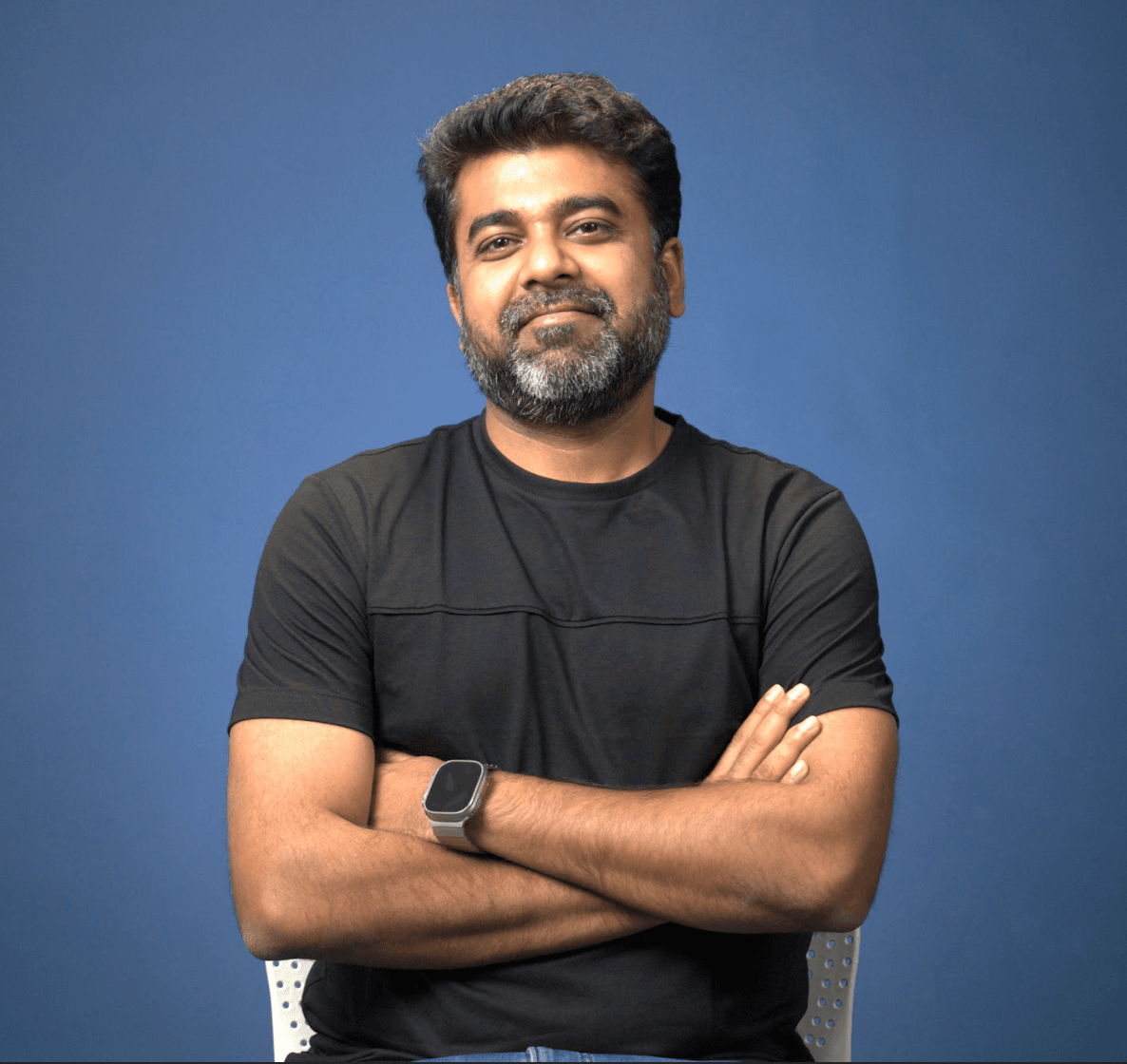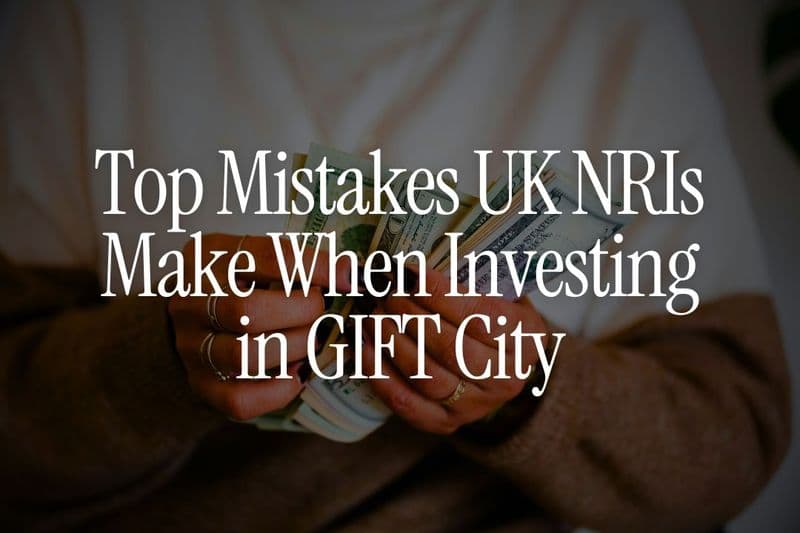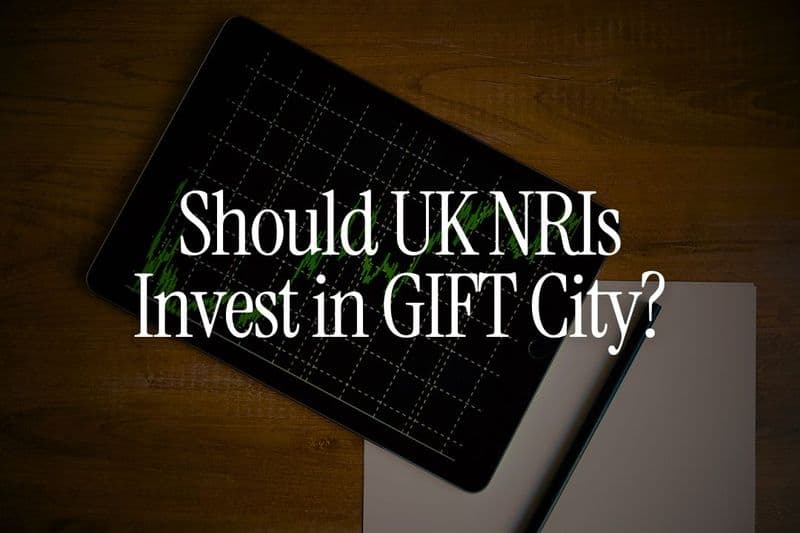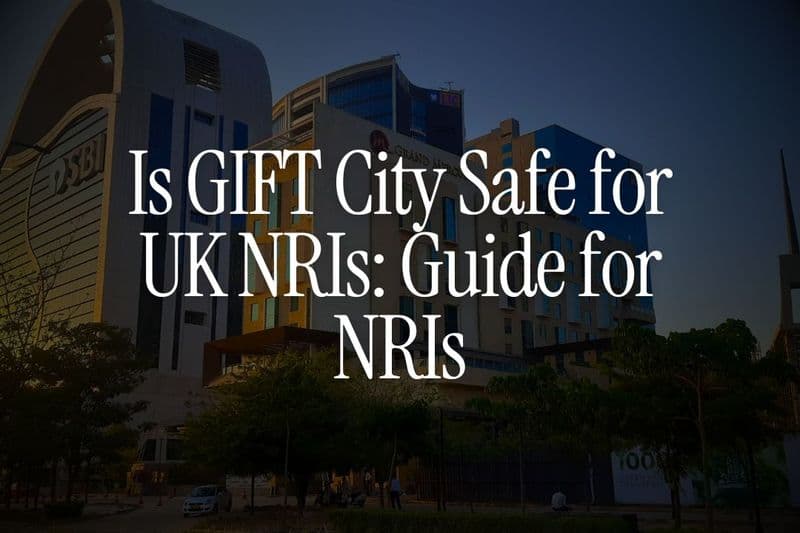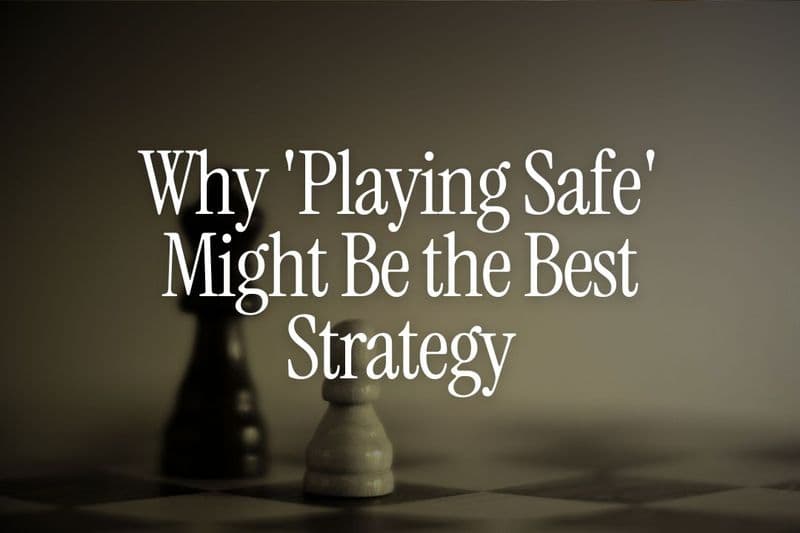
"You're being too cautious, Rajesh. The Indian market will give you 15% returns. Why settle for 6% in fixed deposits?"
That's what Rajesh's broker in Mumbai told him last year. Rajesh, a 42-year-old IT manager in Dubai, had ₹80 lakhs saved over 15 years. He wanted something safe. But the broker convinced him to put it all in mid-cap mutual funds. "India's growth story," the broker said. "You'll double your money in five years."
Today, Rajesh's ₹80 lakhs is worth ₹74 lakhs. He can't sleep at night. He checks the market every morning. His wife is worried. And worst of all? He needs ₹50 lakhs in two years for his daughter's US university fees. Now he's stuck.
Compare that to Meera, also in Dubai, same age, similar corpus. She ignored the noise. Put ₹80 lakhs in GIFT City USD fixed deposits at 6% tax-free. One year later, she has ₹84.4 lakhs. Tax-free. In dollars. She sleeps fine. Her money's growing steadily. Zero stress.
This year, we've seen this pattern repeat with over 500 NRI clients at Belong. The ones who played it safe? They're ahead. The ones who chased high returns? Many are regretting it. Our WhatsApp community is full of both types sharing their stories daily.
Here's what nobody tells you about 2025: It's not a year to be a hero. It's a year to preserve what you've built.
In this guide, we'll show you why playing safe isn't boring or low-return - it's actually the smartest move for NRIs right now. We'll break down what 2025 looks like, why conservative strategies win, which "safe" options still deliver 5-7% tax-free returns, and how to avoid the trap of being too safe.
If you've spent years building your corpus in the UAE or elsewhere, this might be the most important financial article you read this year.
What Does "Playing Safe" Even Mean for NRIs?
Let's get clear on this first. Playing safe doesn't mean hiding money under your mattress or keeping it in a UAE bank account earning 2%.
For NRIs in 2025, playing safe means:
Capital preservation comes first: You don't want your ₹50 lakhs to become ₹45 lakhs because of a market crash. Growth is secondary.
Predictable returns: You know roughly what you'll earn. No surprises. No checking your portfolio every day in panic.
Tax efficiency built-in: Returns stay in your pocket, not the government's. Interest on NRE accounts or GIFT City investments is tax-free.
Currency protection: Your money doesn't lose value when the rupee falls. USD-denominated investments protect you.
Easy repatriation: When you need money, you can send it back to the UAE quickly without paperwork nightmares. Full repatriability matters.
Regulatory safety: Government-backed or SEBI-regulated options. No fly-by-night schemes.
Liquidity when needed: You can access money in emergencies without huge penalties or waiting periods.
Playing safe in 2025 means choosing investments that tick most of these boxes. It means accepting 5-7% tax-free returns instead of chasing 15% with high risk. And here's the thing - that 5-7% tax-free often beats the 15% after you factor in tax, currency loss, and sleepless nights.
Real example from our community: Vikram had ₹1 crore in equity mutual funds. Last year they gave him 18% returns. Sounds great?
He paid 12.5% LTCG tax, lost 3% to rupee depreciation against the dollar, and stressed constantly about market swings. Net real return in USD terms: about 2%.
His colleague Priya kept the same ₹1 crore in GIFT City FDs at 5.5% tax-free in USD. Actual return: 5.5% with zero tax, zero currency risk, zero stress. Who won?
👉 Tip: Use our NRI FD Rates Tool to compare safe investment options across banks instantly. Updated daily with the latest rates from HDFC, ICICI, Axis, SBI, and GIFT City banks.
Why 2025 Is Different: The Case for Conservative Investing
"But the Indian economy is growing. Why play it safe now?" That's what we hear constantly. Here's the reality check based on actual market research from Morgan Stanley, CLSA, and other global brokerages.
Global Economic Uncertainty Is at a Peak
The 2025 market outlook shows mixed views from global brokerages on growth and risks, with emerging market equities facing the triple challenge of ongoing debt-deflationary pressures in China, likely escalation of tariffs, and negative impacts on global growth.
The US Federal Reserve's interest rate decisions will impact global liquidity and foreign investor flows into India. Trump 2.0 presidency could strain trade relations. Geopolitical tensions in West Asia and the Russia-Ukraine conflict continue. These aren't small issues - they directly affect your investments.
Foreign Money Is Leaving India
As of October 2025, foreign investors have withdrawn over $10 billion from Indian equities YTD, amid global volatility., reflecting concerns over slowing economic growth and corporate earnings. When big money exits, markets get shaky. That's not a time to be aggressive.
Indian Market Valuations Are Stretched
CLSA's 2025 India strategy report adopts a cautious tone, forecasting muted returns for the Nifty and citing uncertainty surrounding the global macroeconomic environment along with expensive valuations significantly above historical averages.
When prices are high relative to earnings, future returns tend to be lower. This is basic investing math.
Growth Is Slowing (Slightly)
Growth is likely to soften in 2025 towards 6.5%, as sticky inflation and election-related delays in public spending led to softening urban consumption, with tight financing conditions also weighing in.
Still positive? Yes. But slower growth means companies earn less, which means lower stock returns.
Market Volatility Is Expected
The Sensex and Nifty delivered returns of around 5% year-to-date as of mid-November 2025, underperforming global peers amid high valuations., making India one of the worst-performing equity markets globally amid high valuations and sluggish earnings growth, with the Volatility Index signaling heightened swings.
High volatility means your ₹50 lakhs could swing to ₹45 lakhs or ₹55 lakhs in weeks. If you need that money in 1-3 years, that's terrifying.
New SEBI Regulations Are Tightening
New surveillance measures include graded restrictions on stocks with unusual price movements, 100% margin requirements, tighter price bands, and in F\&O, upfront premium payments, removal of expiry-day spread benefits, and 2% additional margin on short options, making high-leverage trading riskier for retail investors.
These rules are good for long-term market health, but they increase short-term uncertainty as markets adjust.
What does all this mean for you?
If you're 3-5 years away from needing money (kids' education, retirement, property purchase), 2025 is NOT the year to take big risks. Yes, India's long-term story is solid. Consensus forecast for the next three years estimates India will deliver superior earnings growth for shareholders compared to the US and other developed markets. But short-term? It's bumpy.
Safe investments suddenly look very smart when markets are uncertain. Your job isn't to beat the market - it's to reach your financial goals without losing sleep.
The Hidden Value of "Boring" Investments
Here's what aggressive investors don't tell you about safe investments: They're not actually boring when you factor in the full picture.
They Compound Without Interruption
A 6% return that happens every year for 10 years beats a 15% return that crashes to -20% one year, then 10% the next, then -5%. Consistency wins.
₹50 lakhs at 6% annually for 10 years = ₹89.5 lakhs
₹50 lakhs with wild swings averaging 7% over 10 years but including two crash years = Often ends up lower because you panic-sold during crashes
Tax-Free Means Real Returns
Interest on NRE fixed deposits and GIFT City FDs is completely tax-free. That 5.5% is yours to keep. Compare that to equity mutual funds where you pay 12.5% LTCG tax on gains. A 12% gross return becomes 10.5% after-tax. Suddenly the gap isn't that big.
Zero Emotional Drain
Safe investments let you live your life. You're not checking markets. Not reading financial news daily. Not stressed. That peace of mind is worth something - probably a lot more than the extra 2-3% you might earn by taking big risks.
We had a client, Suresh, who was so stressed about his equity portfolio that he developed blood pressure issues. His doctor literally told him to reduce financial stress. He moved to GIFT City FDs. Three months later, his BP normalized. How much is health worth?
Currency Protection Is a Huge Benefit
The rupee has fallen from ~74 to the dollar in 2020 to around 88.7 in 2025. That's ~20% depreciation in 5 years. If you earned 6% in INR but lost 3% annually to currency fall, your real return in dollar terms is only 3%.
USD-denominated GIFT City investments protect you completely from this. Your 5.5% return stays 5.5% in dollar terms. Track this yourself using our Rupee vs Dollar tracker.
They Let You Sleep at Night
In 2020 during COVID, markets crashed 40% in weeks. Equity investors panicked. Many sold at losses. FD holders? They just waited for their maturity. Their money was safe. The crisis passed. They won by doing nothing.
The sleep-at-night factor is real. If your investment keeps you up at night, it's too risky regardless of potential returns.
You Can Plan Life Better
When you know you'll have ₹84 lakhs in two years from your FD, you can plan your daughter's education confidently. You can book her university admission. You're not hoping the market stays up. You know.
Safe investments give you certainty. In a world of uncertainty, that's incredibly valuable.
👉 Tip: Before investing, determine your residential status using our tool. It affects which accounts you can use and how you're taxed. Takes 2 minutes, could save you thousands.
Safe Investments That Still Deliver Decent Returns
"Okay, I'm convinced about safety. But where do I actually invest?" Here are your options, ranked from safest to slightly less safe (but still conservative).
GIFT City USD Fixed Deposits - Our #1 Pick
Returns: 4.5-6% annually
Tax: Zero in India
Currency: USD (no rupee risk)
Repatriation: 100% instant
Safety: Banks licensed by IFSCA (Indian regulator)
Lock-in: 1-5 years
Why we love it: This is the perfect NRI safe investment. You get FD safety, USD stability, tax-free growth, and instant repatriation. No other option matches this combination.
Real data: A ₹1 crore investment at 5.5% annually for 5 years grows to ₹1.31 crore, tax-free, in USD. Compare that to an NRE FD where you get 6.5% in rupees - if the rupee falls 3% yearly, your actual dollar return is about 3.5%. GIFT City wins.
Check current GIFT City FD rates from different banks and compare them.
NRE Fixed Deposits
Returns: 6-7% annually
Tax: Zero while you're NRI
Currency: INR (rupee risk exists)
Repatriation: Fully repatriable
Safety: Indian banks (mostly government or large private banks)
Lock-in: 1-5 years
Good for: NRIs who believe the rupee will stay stable or strengthen. Those who plan to spend the money in India eventually.
Use our live FD rates tool to see which bank offers the best rate right now. HDFC, ICICI, Axis, SBI, and others are all compared in real-time.
Also Read - Which bank is best for fixed deposit in india
FCNR Deposits
Returns: 3-4.5% annually
Tax: Zero
Currency: Your choice (USD, GBP, EUR, etc.)
Repatriation: Fully repatriable
Safety: Indian banks
Lock-in: 1-5 years
Good for: Ultra-conservative investors who want zero currency risk and don't mind slightly lower returns. People who need money in a specific foreign currency.
Also Read - Best FCNR Deposits for NRIs: Grow Your Savings
Debt Mutual Funds (Conservative)
Returns: 6-8% annually
Tax: Taxes at slab rate upto 30% irrespective of holding period
Currency: INR
Repatriation: Yes (with Form 15CA/15CB)
Safety: Rated bonds, government securities
Lock-in: None (but recommended 3+ years)
Good for: Those okay with some market movement but want lower risk than equity. Offers better tax treatment than bank FDs if you're in a high tax bracket.
Read about taxation of mutual funds for NRIs before investing.
Senior Citizen FDs (If You're 60+)
Returns: 7-8% annually
Tax: Taxable in India if on NRO account
Currency: INR
Repatriation: Depends on account type
Safety: Government schemes
Lock-in: 5 years (some exceptions)
Good for: Retirees who want high guaranteed returns and are okay with some tax liability.
Guaranteed Return Insurance Plans
Returns: 5-6% annually
Tax: Tax-free under Section 10(10D) if premium is below ₹2.5L annually
Currency: INR
Repatriation: Yes
Safety: Life insurance companies (IRDAI regulated)
Lock-in: 5-10 years
Good for: Those who want insurance plus guaranteed savings. Useful for NRI life insurance planning.
Sovereign Gold Bonds
Returns: Linked to gold price + 2.5% annual interest
Tax: LTCG exempt if held till maturity (8 years)
Currency: INR
Repatriation: Yes
Safety: Government of India backed
Lock-in: 5 years minimum, 8 years for full tax benefit
Good for: Diversification. Hedge against inflation. Long-term holding. Read about gold investment for NRIs.
Comparison Table: Safe Investment Options for NRIs
Investment | Return | Tax Status | Currency Risk | Repatriation | Best For |
|---|---|---|---|---|---|
GIFT City FD | 4.5-6% | Tax-free | None (USD) | 100% instant | Everyone |
NRE FD | 6-7% | Tax-free | Yes (INR) | 100% | INR optimists |
FCNR FD | 3-4.5% | Tax-free | None | 100% | Ultra-safe |
Debt MF | 6-8% | 12.5% LTCG | Yes (INR) | Yes | Tax planning |
Sr Citizen FD | 7-8% | Taxable | Yes (INR) | Partial | 60+ age |
Insurance | 5-6% | Tax-free | Yes (INR) | Yes | Long-term |
Gold Bonds | Gold + 2.5% | Tax-free (8yr) | Yes (INR) | Yes | Diversification |
When "Playing It Safe" Becomes Risky
Here's the paradox: Being too safe can hurt you. Let us explain.
Inflation Eats Your Returns
If inflation is 5% and you earn 3% in a UAE bank account, you're actually losing 2% in purchasing power every year. Your money grows in number but shrinks in value.
India's economy offers NRIs higher growth potential with real estate prices appreciating steadily and returns on Indian investments often outpacing those in developed countries, making India an attractive long-term wealth-building option.
You need returns that beat inflation. That's why we recommend 5-7% options, not 2-3%.
Also Read - How Inflation in India Impacts Your Retirement Savings from the UAE.
Currency Risk Works Both Ways
Yes, the rupee can fall. But it can also strengthen. If you keep all money in USD and need to spend in India, you could lose. Diversification across currencies makes sense.
Opportunity Cost Is Real
₹50 lakhs at 3% for 10 years = ₹67 lakhs
₹50 lakhs at 6% for 10 years = ₹89.5 lakhs
That's ₹22.5 lakhs you gave up by being too cautious. Money you could have used for your child's MBA or your retirement travel.
Emergency Funds Tied Up
If you lock everything in 5-year FDs because they offer slightly higher rates, what happens when you have an emergency? You either break the FD (penalty) or take expensive loans.
Keep 20-30% liquid in savings accounts or short-term deposits. The rest can be in longer-term FDs.
Tax Planning Ignored
If you're still filing in India, you could be missing deductions like Section 80C, 80D, home loan interest. Playing it "safe" by putting everything in FDs means you miss tax-saving opportunities that could add 1-2% to your effective returns.
Read our guide on NRI tax filing to understand your obligations and benefits.
Missing DTAA Benefits
Many NRIs don't claim Double Taxation Avoidance Agreement benefits. If you paid tax in India, you can often get relief in your home country. Not doing this means paying tax twice - very unsafe for your wallet.
Learn about DTAA between India and UAE to avoid double taxation.
Not Matching Investments to Goals
You need money in 2 years for your kid's college, but you put it in a 5-year FD because the rate is better? That's not safe planning - that's mismatched planning.
The right approach: Match each goal to an appropriate investment based on time horizon and risk tolerance. Use our compliance compass to make sure you're following all rules.
Real Stories: NRIs Who Won by Playing It Safe
Let us share actual stories from our Belong community (names changed for privacy).
Story 1: The Man Who Ignored FOMO
Ashok, 45, software engineer in Abu Dhabi. In 2023, everyone around him was making money in stocks. His WhatsApp groups were full of screenshots showing 40% gains. His friends mocked him for keeping ₹60 lakhs in NRE FDs at 6.5%.
"You're missing out," they said. "Indian stocks are on fire."
Ashok almost gave in. But he remembered he needed this money in 2026 for his daughter's medical school in the US. He couldn't afford to lose even ₹5 lakhs.
He stuck to his FDs. Today, he has ₹69.5 lakhs, guaranteed, tax-free. His friends? Most broke even or lost money when the market corrected in 2024-25. The ones who made money are now stuck because they don't want to sell at "low" prices.
Ashok sleeps well. His friends don't. Who won?
Story 2: The Couple Who Split Their Strategy
Kavita and Raj, 50 and 52, planning to return to India in 2028. They had ₹1.2 crore saved.
Instead of going all-in on safety or all-in on growth, they split:
- ₹60 lakhs in GIFT City USD FD (6%, tax-free, zero currency risk)
- ₹40 lakhs in NRE FD (6.8%, tax-free, but rupee risk)
- ₹20 lakhs in balanced mutual funds (moderate growth + stability)
After 2 years:
- GIFT City: ₹66.6 lakhs (guaranteed, no stress)
- NRE FD: ₹45.5 lakhs (good returns, some rupee depreciation in dollar terms)
- Mutual funds: ₹22.5 lakhs (12% average return)
Total: ₹1.35 crore from ₹1.2 crore. Overall return: 12.5% over 2 years, with most of it in safe investments. They're happy. They're on track. They sleep fine.
Story 3: The Early Retiree Who Chose Peace Over Returns
Sameer, 58, took early retirement from his Dubai job. Got ₹2 crore as retirement payout. His broker pushed him toward equity funds. "You're only 58. You have 30+ years ahead. Take some risk."
Sameer thought differently. "I worked 30 years to build this. I'm not gambling it."
He put:
- ₹1.2 crore in GIFT City FDs (6% tax-free)
- ₹60 lakhs in FCNR USD deposits (4% tax-free)
- ₹20 lakhs emergency fund in NRE savings
Annual income: ₹66,000 from GIFT City + ₹24,000 from FCNR = ₹90,000 tax-free passive income. Plus his pension. He's living comfortably in Bangalore now. Zero stress. Zero market watching.
His broker friends lost clients' money in the market downturn. Sameer? He's traveling, spending time with grandkids, and sleeping without anxiety.
Story 4: The Young Professional Who Balanced Both
Neha, 32, HR manager in Dubai. Young, has time, but also cautious. She invests ₹75,000 monthly:
- ₹35,000 in GIFT City FD (building safe base)
- ₹25,000 in Indian equity mutual funds (for growth)
- ₹15,000 kept liquid
After 3 years, her safe portion (GIFT City) grew to ₹14.5 lakhs. Her equity portion is at ₹10.2 lakhs (market hasn't been great). Total: ₹24.7 lakhs.
But here's the key: She's not stressed. The GIFT City portion is her safety net. The equity is bonus. If markets crash, she has her base covered. If they boom, she benefits.
Smart strategy for someone with 25+ years to retirement.
👉 Tip: Join our WhatsApp community to hear more real stories from 3,000+ NRIs sharing their investment experiences daily.
How to Implement a Safe Investment Strategy (Step-by-Step)
Enough theory. Here's exactly what to do if you want to play it safe in 2025.
Step 1: Calculate Your Needs by Timeline
List out when you need money:
0-2 years: Emergency fund, known expenses (property down payment, child's school fees)
2-5 years: Big goals (child's university, buying property, returning to India)
5-10 years: Medium-term wealth building
10+ years: Retirement, long-term wealth
Don't mix these up. Money you need in 2 years cannot be in 5-year FDs or equity funds. Period.
Step 2: Build Your Emergency Buffer First
Before any investment, park 6-12 months of expenses in an instant-access account:
- NRE savings account (3-4% interest, tax-free)
- UAE bank account (instant access)
- Sweep-in FD (earns FD rate but gives instant liquidity)
This is non-negotiable. Without this, one emergency will force you to break FDs and lose money.
Step 3: Check Your Residential Status
Are you NRI, RNOR, or Resident? This determines which accounts you can use and how you're taxed.
Use our residential status calculator - it takes 2 minutes and affects everything.
Step 4: Open the Right Accounts
You need:
- NRE account for foreign earnings, fully repatriable, tax-free interest
- NRO account for Indian income (rent, dividends), limited repatriation
- GIFT City account for USD investments (open through Belong)
We help NRIs open GIFT City accounts with KYC done at your doorstep in Dubai. Download the Belong app to start.
Step 5: Allocate Based on Safety Needs
For conservative NRIs (age 50+, near retirement):
- 70% GIFT City FD + FCNR
- 20% NRE FD
- 10% liquid savings
For moderate NRIs (age 35-50, mid-career):
- 50% GIFT City FD + NRE FD
- 30% balanced mutual funds
- 20% liquid + emergency
For young NRIs (age 25-35, early career):
- 30% GIFT City FD (safety base)
- 50% equity mutual funds (growth)
- 20% liquid + emergency
Step 6: Diversify Currency Exposure
Don't keep everything in one currency. A good mix:
- 40% USD (GIFT City FDs)
- 40% INR (NRE/NRO)
- 20% in your country's currency (UAE dirham, pound, etc.)
This protects you regardless of which currency moves.
Step 7: Ladder Your Fixed Deposits
Don't put ₹1 crore in one 5-year FD. Split it:
- ₹20 lakhs maturing in 1 year
- ₹20 lakhs maturing in 2 years
- ₹20 lakhs maturing in 3 years
- ₹20 lakhs maturing in 4 years
- ₹20 lakhs maturing in 5 years
This gives you access to ₹20 lakhs every year, plus you can reinvest at current rates. Learn about FD laddering strategy.
Step 8: Automate Everything
Set up:
- Monthly SIPs if doing mutual funds
- Auto-renewal for FDs
- Automatic fund transfers
The less you manually do, the less you'll make emotional decisions.
Step 9: Review Once a Year, Not Daily
Check your portfolio once a year. That's it. If you're in safe investments, daily checking is pointless and stressful. Set a calendar reminder for January every year.
Step 10: Rebalance When Life Changes
Got a promotion and salary increase? Add to investments.
Planning to return to India in 2 years instead of 5? Move long-term investments to short-term safe ones.
New baby? Increase emergency fund.
Life changes, strategy changes. But the core principle stays: safety first.
The Biggest Myths About Safe Investing (Busted)
Myth 1: "Safe investments don't beat inflation"
Reality: A 6% NRE FD or 6% GIFT City FD beats India's average inflation of 4-6%. You're growing real wealth.
Myth 2: "You need to take risks to build wealth"
Reality: Compounding does the heavy lifting. ₹50 lakhs at 6% for 20 years = ₹1.6 crore. Zero risk needed.
Myth 3: "Fixed deposits are for old people"
Reality: Smart young people use FDs as their safety base, then take calculated risks with surplus. Neha's story proves this.
Myth 4: "NRIs should invest in equity to beat rupee depreciation"
Reality: USD-denominated GIFT City FDs protect against rupee fall better than equity, with zero volatility.
Myth 5: "Safe means low returns"
Reality: After tax and currency adjustments, a 6% tax-free USD FD often beats a 12% taxable equity fund that's exposed to currency risk.
Myth 6: "You're wasting opportunity if you don't invest in stocks"
Reality: Stocks crash 30-50% periodically. If you need money during a crash, you're stuck. FDs never crash.
Myth 7: "Playing safe means you're scared"
Reality: Playing safe means you're smart. Risk-adjusted returns matter more than absolute returns.
When You Should Still Take Some Risk
Playing safe is smart, but it's not for 100% of your money in every situation.
Take calculated risks if:
You're under 35 and have 25+ years to retirement. Time heals market wounds. A 30% crash recovers over 5-10 years.
You have a stable high income and can afford to lose some money. If losing ₹5 lakhs doesn't affect your life, you can chase higher returns with that amount.
Your emergency fund and short-term needs are fully covered. If you have 2 years of expenses safe, you can risk surplus money.
You have other sources of retirement income (pension, property rent). Your FDs aren't your only safety net.
You're investing small amounts monthly (SIP). Rupee cost averaging reduces risk over time.
But even then, don't go all-in on risk. Keep 50-60% in safe investments. Use the rest for growth. Balance is key.
Read our guide on balancing tax planning and investment growth for more on this.
What We're Telling Our Clients at Belong
At Belong, we're seeing a clear trend. The NRIs who built wealth steadily? They played it safe with the bulk of their money.
Yes, some made killings in stocks. But for every one success story, we see five who lost money or barely broke even after factoring in tax, currency, and stress.
Our recommendation for 2025:
If you're 40+: Put 70-80% in safe options (GIFT City FD, NRE FD, FCNR). You don't have time to recover from crashes.
If you're 30-40: Split 50-50 between safe and moderate growth. Build your safety net while participating in growth.
If you're under 30: 60% growth, 40% safe. You have time, but even young people need stability.
If you're returning to India in 5 years: 90% safe. You cannot afford volatility near your return date.
The common thread? Everyone needs a safety base. The only difference is the percentage.
We've helped over 10,000 NRIs set up their GIFT City accounts in the last year. Why GIFT City? Because it gives you:
- Tax-free returns (5-6% annually)
- USD protection (zero rupee risk)
- Instant repatriation (no paperwork, no delays)
- SEBI regulation (fully legal and safe)
- No NRE/NRO confusion (separate from Indian banking)
It's the smartest safe investment for NRIs in 2025. Period.
Want to explore this? Download the Belong app now. We'll help you compare GIFT City FDs across banks, show you exact returns, and open an account with KYC done at your doorstep in the UAE. The process takes 10 minutes.
Your 2025 Safe Investment Checklist
Before you invest anywhere, check these boxes:
I know my exact residential status (NRI/RNOR/Resident)
I have 6-12 months emergency fund in liquid accounts
I've matched each investment to a specific goal and timeline
I understand the tax implications (NRE vs NRO vs GIFT City)
I know how to repatriate funds when needed
I'm not chasing returns I saw on social media or WhatsApp forwards
I've checked current FD rates before deciding
I'm diversifying across currency (INR + USD + home currency)
I've claimed DTAA benefits if applicable
I've filed ITR if required
I'm not keeping all money in one bank or one type of investment
I've educated myself on repatriation rules
If you checked less than 10, you have homework to do. Join our WhatsApp community and ask questions. We'll help.
Final Thoughts: The Smartest Move Is Often the Simplest One
Here's what 15 years of advising NRIs has taught us at Belong:
The ones who sleep well at night are the ones who built wealth slowly and safely. The ones who had sleepless nights are the ones who chased returns and took big risks.
Playing safe in 2025 isn't about fear. It's about wisdom.
You've worked hard for your money. You've saved ₹20 lakhs or ₹50 lakhs or ₹1 crore over 10-15 years in the UAE. You don't need to gamble it for an extra 3% return. You need to protect it, grow it steadily, and use it for your goals.
The beauty of safe investing? It works. It's boring, yes. But boring builds wealth more reliably than exciting.
6% tax-free in USD through GIFT City FDs. 6.5% tax-free through NRE FDs. These aren't sexy returns. But they're predictable, safe, and they compound without interruption.
That's how you win. Not with one big bet, but with consistent safe choices over 10-20 years.
Ready to start? Here's what to do today:
- Download the Belong app and check live GIFT City FD rates
- Use our residential status calculator to confirm your tax status
- Join our WhatsApp community and ask any questions
This week:
- Compare current FD rates using our comparison tool
- Calculate how much you need for each goal
- Decide on your safe vs growth split
This month:
- Open a GIFT City account through Belong (we do KYC at your Dubai doorstep)
- Move at least 50% of savings to tax-efficient safe investments
- Set up automatic monthly investments if doing SIPs
Your wealth deserves safety and steady growth. Let's make it happen together.
Sources
Business Standard: "2025 market outlook and investment strategies for investors in India"
Outlook Business: "India Market Outlook 2025: Mixed Views from Global Brokerages"
Asia Fund Managers: "India equity market outlook Q2/2025"
Business Standard: "Market outlook 2025: Brokerages on opportunities, risks, investible themes"
New Kerala: "India Stock Market 2025 Survival Guide for Investors"
Aberdeen: "Outlook 2025: taking the temperature on India"
Nemi Wealth: "Best Investment Options for NRIs in India 2025"
